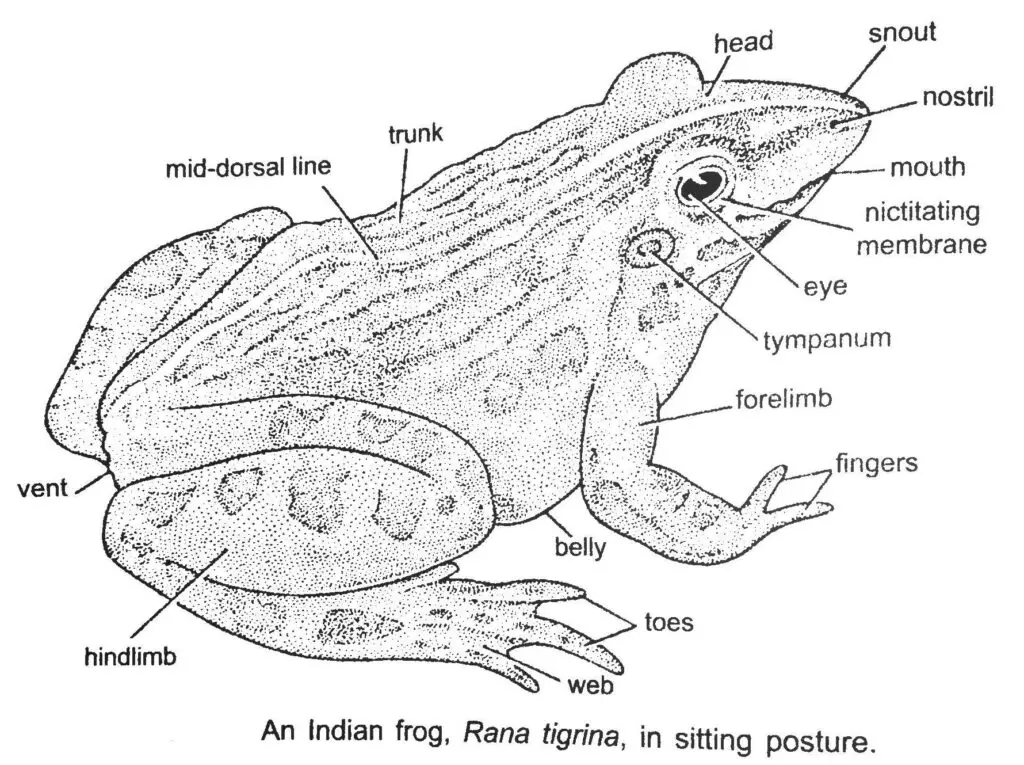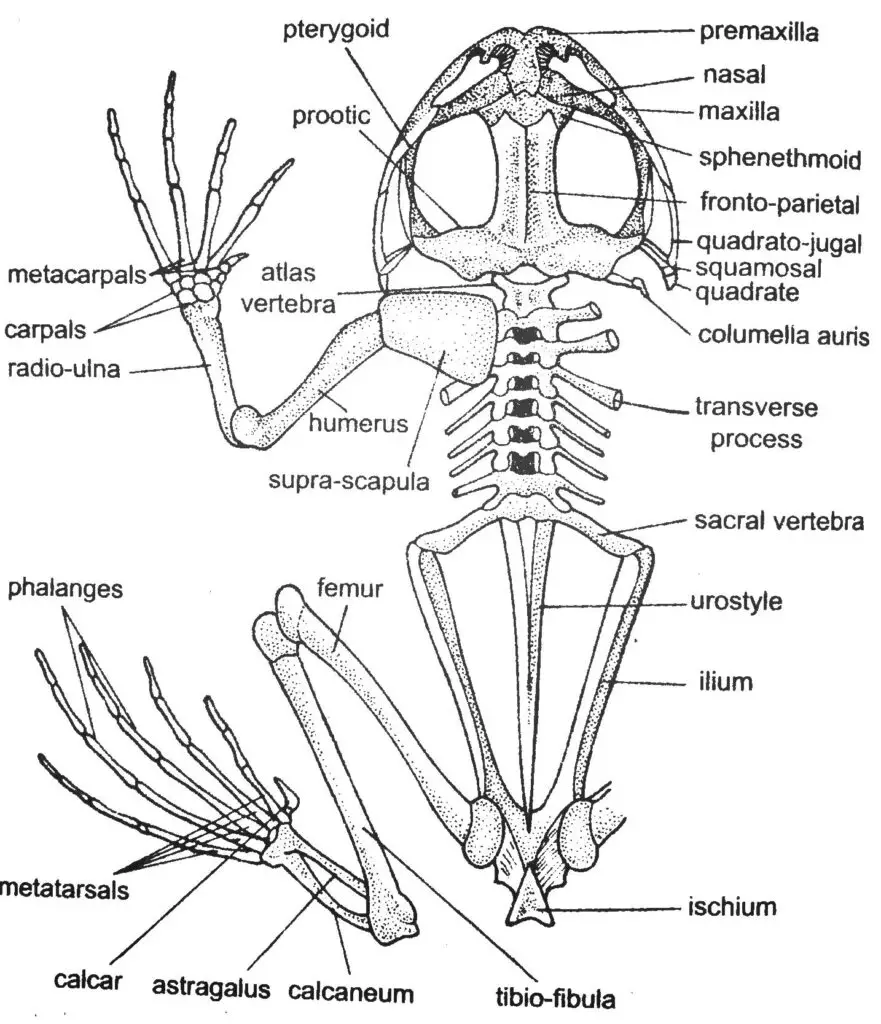name 2 ways forelimbs are different than hind limbs
- Forelimbs & Hindlimbs of anuran
- 1. FORELIMBS
- 2. HINDLIMBS
- Characteristics of Frog's forelimb
- Characteristics of Frog's hindlimb
- Bod of Frog's forelimb
- Fles of Gaul's hindlimb
- How are forelimbs antithetic than hindlimbs in frogs? Let's know the key differences
- Difference: Frog's Forelimb vs. Hindlimb
Frogs move by jumping and swimming and in both of the cases the long hindlimbs play the foreman role.
When the frog is in its resting position, the body remains inclined upward in front being underslung on the forelimbs with its thumb pointing nearly backward. While the posterior part remains in the primer coat with the hindlimbs being folded.
The toad uses its hindlimb to jump off itself sprouted in the aerial just like-minded a spring for jumping movements, and the forelimbs provides the direction of jump-start.
During swimming movements, the hindlimbs help the frog to float forward by dynamical the water backward. The forelimbs help IT to float downward by beating the water upwards or swim upward by beating downward.
DO YOU KNOW: Amphibians (which includes frogs, salamanders, etc) were the first group of vertebrates in the Deer-like Kingdom to develop limbs and to be able to leave the water to conquer the land.

Forelimbs &A; Hindlimbs of frog
1. FORELIMBS
In that location are two forelimbs attached to the anterior percentage of the trunk and each one is situated at each side of the batrachian's body. The forelimbs are shorter, spell the hindlimbs are larger and mesomorphic in nature.
The forelimbs are utilised to support the front part of the frog's body while jumping or while at rest. These as wel helps to control the drift instruction of the frog while swimming or jumping.
Each forelimb comprises of an upper arm, a forearm, articulatio radiocarpea, and hand with four digits and vestigial rif.
The bones of forelimbs include humerus, radio-ulna, and the bones of hand.
2. HINDLIMBS
There are two hindlimbs committed to the posterior depart of the automobile trunk and each one is settled at each side of the frog's body.
Each hindlimb comprises of an upper berth thigh, lower leg, ankle, and long groundwork with a narrow sole. The long foot with a straplike sole has five digits related by broad thin webs of shin which help the frog in swimming.
The bones of forelimbs include femoris, tibio-fibula, astragalus-calcaneum, and finger cymbals of hoof.
Frogs can easily adapt to the surroundings using hindlimbs. The main reason is that the hind limbs are too athletic in nature with strong muscle fibres that allow it to jump advanced to well escape its vulture and too to catch its prey.
Characteristics of Frog's forelimb
Forelimbs are those two limbs that are found in the front part of the frog's physical structure. They use their forelimbs for burrowing, supporting their anterior body, swim upward or down, or provide direction during a jump.
The forelimbs are utilized in an alternating fashion in a diagonal sequence one after the other, and that the spatial relation of the limbs is adjusted when walking on substrates of diverse diameters.
The forelimbs besides help in providing a decent grip and friction on the substratum in contact. The gripping force shows different differences between species.
In males, the base of the premier (inner) fingerbreadth is thickened specially in the breeding season, forming the nuptial pad for clasping the feminine at the time of mating.
After a broad jump, the forelimbs due to its great mobility of the digits help the frog to hang on a substratum and baffle a proper grip. This helps them to invalidate damaging the sensitive and soft belly of frogs.
Some species of frogs are fifty-fifty known to use their forelimbs to clean their faces and eyes, and if their feed is not entirely in their sass they'll use those arms to get-up-and-go IT into their mouth more and better grab the prey.
Characteristics of Frog's hindlimb
The hindlimbs of frogs are larger than the forelimbs. The hindlimbs are very athletic in nature and help the salientia's oppressive physical structure to be raised high up in the air.
During tearful, the hindlimbs help the frog to move the torso forward in the water, in or against the water prevalent.
They do utilize their back legs ready to easy propel themselves through the urine while they are swimming, and they use their fore legs systematic to steer themselves.
The powerful and sporty style of jumping motivity in frogs is just powered by the hindlimbs. Hindlimb bones of frogs are extremely able to defy the possibly erratic loads associated with high elastic jumps.
Likewise, the belly of frogs is non very protected and has relatively very sensitive soft skin. If they didn't have hindlimbs to land themselves later a high-stepped jump, then they would end up slamming into the ground appropriate on their belly.
The best locomotory organ of the salientia is its hindlimbs. The main reason is that it can jump high to well escape from its predator and also to catch its prey.
Many species of frogs have been reportable with the ability to burrow soil with their hindlegs. Their toes are tough with claw-wish endings that help them to properly grab and move soil.
Umpteen corner frogs have an unpaid ability to climb, and this is achieved due to the vertical climbing power of the hindlimbs.

Anatomy of Batrachian's forelimb
The bones of forelimbs admit humerus, radio-ulna, and the castanets of hand.
Humerus is the bone of upper arm of forelimb. Information technology is myopic and rounded in structure with a slightly curved shaft. It attaches the forelimb with the pectoral waistclot.
Radio-elbow bone is a compound cram of the forearm of forelimb. It is formed aside the fusion of radius and elbow bone bones together.
The bones of the wrist are called carpels and, these carpels are 6 in number and is organism organized in two rows of iii each.
The clappers of hand includes carpels, ulnare, centrale, radiale, capitohamatum, os trapezoideum, and Trapezium, metacarpels, and phalanges.
The hand is with five supple metacarpals and phalanges. The digit of the ovolo is inattentive with zero metacarpals and phalanges.
Material body of Frog's hindlimb
The maraca of hindlimbs include femur, tibio-calf bone, astragalus-calcaneum, and bones of foot.
Femoris is the bone of thigh region of the hindlimb. It is real long and slender having a slightly curved shaft. It attaches the trunk with the girdle waistclot.
Tibio-fibula is the bone that is formed with the spinal fusion of an inner tibia bone and external fibula bone.
Astragalus-calcaneum is the bone that supports the ankle of the hindlimbs. It is made up of two rows of four skeletal structure castanets that are fused together at their proximal or lateral ends.
The foot is supported by quint long and slender metatarsals with phalanges carriage 5 true toes.
How are forelimbs different than hindlimbs in frogs? Let's know the key differences
Forelimbs are short piece the hind limbs are large.
The hindlimbs allow for support to the posterior part of the frog's organic structure while the forelimbs support the anterior part of the frog's body.
The hindlimbs of frogs are much stronger than the forelimbs. The finger cymbals of the hindlimbs are sturdier and longer than the bones present of the forelimbs.
The hindlimbs are attached to the pelvic stays whereas, the forelimbs are attached to the pectoral sash.
The forelimbs help oneself in holding the surface, liquid upwardl or downward in water, provide direction during a jump, rotation, and helps the frog to admit on a substratum and pay back a proper grip.
The hindlimbs help in climbing, high jumping, escaping from predators, propellant in water, and land the body smoothly after potentially high elastic jumps.
Moreover, the male frogs can be distinguished by the presence of a marriage ceremony embroider (hitchhike pad of paper) on the number 1 digit of the forelimbs (not hindlimbs), which are remove in female frogs.
Leg bone macroglans are present tense on the hindlimbs, and straight line macroglands on the forelimbs of toad.
Difference: Frog's Forelimb vs. Hindlimb
| Groundwork FOR COMPARISON | FORELIMB OF FROG | HINDLIMB OF Toad |
|---|---|---|
| Locating | At the antecedent persona of the anuran's body (at trunk part). | At the posterior persona of the frog's body (at trunk role). |
| ATTACHED TO | Thoracic Girdle os. | Girdle Waistclot boney. |
| Castanets OF THE Tree branch | Humerus, radio-elbow bone, carpels, ulnare, centrale, radiale, capitohamatum, trapezoid, and trapezium, metacarpels, and phalanges. | Femoris, tibio-fibula, Astragalus-calcaneum, metatarsals, and phalanges. |
| SIZE | Shorter than hindlimbs. | Longer than forelimbs. |
| USED FOR | Close, swimming, rotating, supporting the anterior body, holding, fascinating, and burrowing. | Jumping, propellent in piddle, climbing, supporting the nates consistency, and burrowing. |
| NO. OF DIGITS | 4 digits | 5 digits |
| Front OF WEBBED Arm | No! Digits are separate and free soul-stirring. | Yes! Digits are consolidated together using a flap of peel. |
| MUSCLES OF THE LIMB | Flexor, biceps, and triceps | Obturator internus (OI), Quadratus femur (QF), and Pectineus (Pec) |
name 2 ways forelimbs are different than hind limbs
Source: https://onlyzoology.com/difference-between-forelimb-and-hindlimb-of-frog/
Posting Komentar untuk "name 2 ways forelimbs are different than hind limbs"